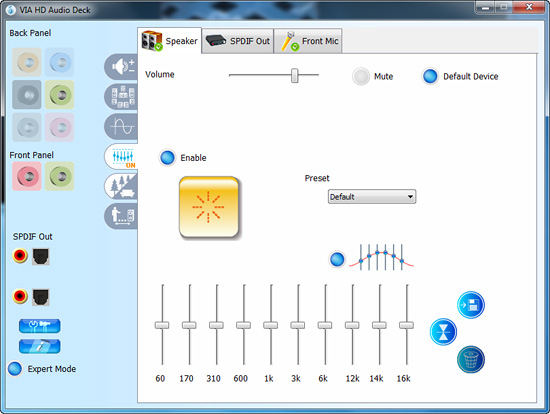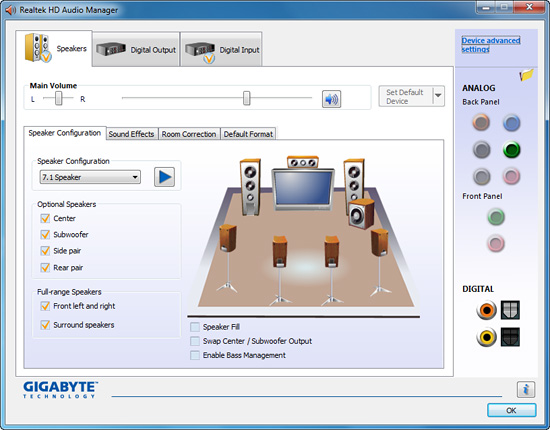Budget Micro-ATX P55 Faceoff: Gigabyte GA-P55M-UD2 and ASRock P55M Pro
by Gary Key on October 5, 2009 12:30 PM EST- Posted in
- Motherboards
Audio-
We are planning on taking an in-depth look at all of the current on-board audio codecs and compare them to a couple of discrete audio cards from ASUS and AuzenTech in the near future. In the meantime, we will provide a quick overview of the control panels from the two competing solutions today and a quick subjective analysis.

ASRock utilizes the VIA VT1708S 8-channel audio codec on the P55M Pro motherboard. To be honest, I had low expectations of this particular chipset. In actuality, it is a decent competitor to the Realtek ALC 888B utilized by Gigabyte. In fact, VIA has made great progress in their driver set and at this point I firmly believe the actual implementation by the motherboard manufacturer in regards to shielding is more important to audio quality than the any potential differences between the two chipsets.
That said, VIA has a very good control panel and option setup, certainly more so than Realtek in this particular case. The most beneficial item is the equalizer as you will need it for music playback. Midrange performance on this chipset is lacking depth and highs at times sound tinny. Both chipsets scored about even in Rightmark’s excellent Audio Analyzer software test suite with THD+ numbers slightly favoring the Realtek solution.
Unfortunately, my ears thought the difference in quality between the two solutions was a bit greater. The main problem with the VIA solution as implemented by ASRock was background noise that was directly attributable to electrical shielding problems on the board. In headphone mode, I could hear a slight background hum that would rise and fall with load activity on both the CPU and storage subsystems. It was very slight, but just enough to be noticeable in several classical and jazz soundtracks. It was also present in several games, mainly simulations and RTS games where there is not constant gunfire present in most first person shooters.

Gigabyte utilizes the Realtek ALC 888B 8-channel audio codec on the P55M Pro motherboard. Audio quality in music was better than the VIA VT1708S thanks to clearer midranges, but highs were still leaned on the tinny side and bass was even between the two chipsets.
Otherwise, I preferred the Via solution in games and movie playback, not by much, but channel separation was slightly better. Of course, if you really want better analog output a good discrete audio card is the solution. For most of us, either of the audio solutions will suffice, but thanks to the lack of background noise, we will have to give the Gigabyte board the win here.





















55 Comments
View All Comments
yacoub - Tuesday, October 6, 2009 - link
785G is just onboard graphics halfbreed between 780 and 790 or whatever. until AMD releases a new line of high-end boards worth reviewing, why bother?haplo602 - Wednesday, October 7, 2009 - link
P55 is just half a chipset, i5 took over some of the functionality anyway ... why bother ?tommy101 - Wednesday, September 8, 2010 - link
beastyhacks79.smfnew.com the best psp hacking sitebollux78 - Tuesday, October 6, 2009 - link
Why do we need PCI anymore? I´ll tel you why: The PCI bus is more than enough for a hell bunch of applications, that´s it. If you have a damn good sound card or video capture, or whatever the card you have, and it´s PCI, you´d love to have the slot in there, because you don need to ditch that card and bet a "fantastic" PCIE x1 new card.C´mon people, let´s use the computer for the right purpose, not just to give money to the manufacturers buying new parts that you don´t
necessarily need.
I know, I´m being inflexible and oldschool, but, please, evolution is one thing, marketing is a completely different animal.
strikeback03 - Tuesday, October 6, 2009 - link
IMO it is more a board real estate problem than a case of buying the latest and greatest. On these P55 uATX boards you have 4 slots, one of which has to be devoted to graphics unless it is a headless server. If you use a dual slot graphics card (which a substantial portion of the readers on this site) you lose a second slot, and ideally you would have an open slot beneath that to ease airflow. So that leaves you with one or in a pinch two slots, therefore what interface they are is quite important. PCIe has been out on boards for what, 5-6 years now? I'd say its time to stop selling PCI cards and leave the PCI slots only on full ATX boards (plus maybe a few HTPC-oriented uATX boards) and let the interface finally die off.Though I'd say IDE has even less of a place now, SATA hard drives have been the norm for years and even optical drives for a few years. Time to upgrade if you are still carting one of those around.
sonicdeth - Monday, October 5, 2009 - link
Thanks Gary for the detailed review. Can't wait for the p55 roundup, and I'm also very interested now in your audo codec review.mindless1 - Monday, October 5, 2009 - link
... but I don't see the sense in SLI on mATX. Using the typical long video cards means you can't have a shorter depth case, just shorter height and since when is the area above your computer case a vital piece of real-estate?With 2, 8 or 16X slots onboard it only makes sense to me to go full ATX, is someone with the system budget to build a powerhouse gaming machine really poor enough, indescriminating enough, or young enough (to not have desirable cards from past systems) they don't want to add some other cards?
I hate to say it but this is getting to be a madness, the idea that we need to focus centrally on gaming ability of a board. Most people are not hard core gamers, but factually speaking, most hard core gamers don't do SLI either. Granted you can use a 16x slot for cards with fewer lanes, that seems the only saving grace for the two boards.
It's getting to the point I want a cTX case design where the drive racks are not in front of the mainboard and PSU, they are above them, so the case is even taller than std. ATX but not as deep.
Might tip over a little easier but earthquakes are rare here and plenty of other household items are more tip-happy than that would be.
strikeback03 - Monday, October 5, 2009 - link
There are cases made to hold a uATX board lying on the bottom, making it kinda a wider Shuttle. I'm personally looking for full ATX as well though, as the height doesn't matter too much to me (pretty sure anything short of a ABS Canyon or some of the bizarre decorative cases would fit under my desk) and don't want to limit my slot selection.Sunburn74 - Monday, October 5, 2009 - link
Hey Anand,Gigabyte boards have on issue that drives me nuts. As soon as you start overclocking them, you lose the ability to S3 sleep. When you do your maximal overclocks for various board reviews, would you mind testing if S3 sleep was maintained at those maximal overclocks?
Gary Key - Monday, October 5, 2009 - link
This board resumes from S3 (USB keyboard) at up to 215 Bclk (mentioned in the thoughts section, make that more visible next time) with our setup and that includes an external hard drive on the Firewire port which is properly instructed to shut down and restart.